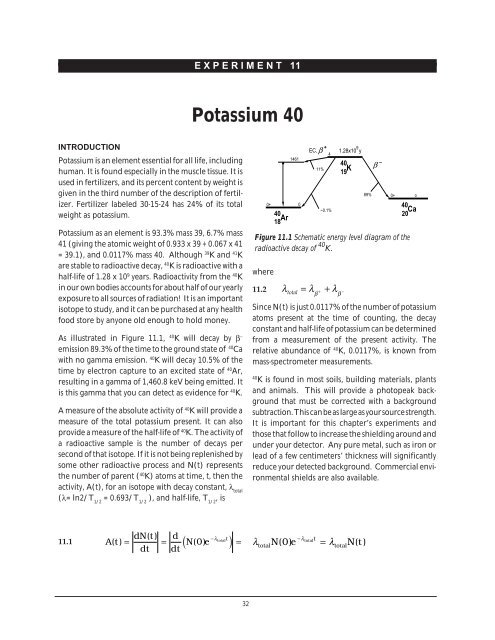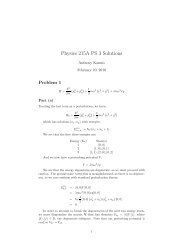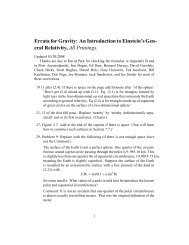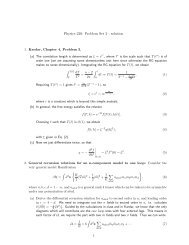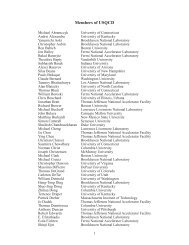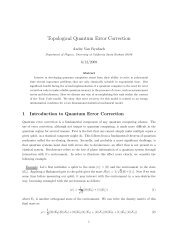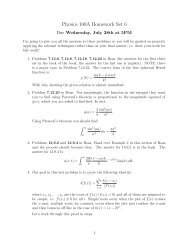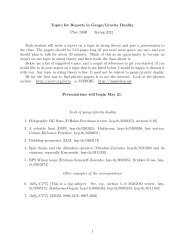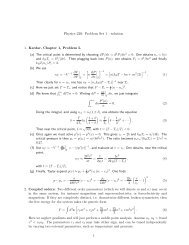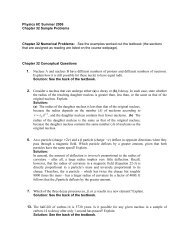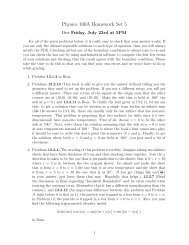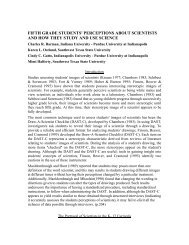Nuclear Spectroscopy
Nuclear Spectroscopy
Nuclear Spectroscopy
You also want an ePaper? Increase the reach of your titles
YUMPU automatically turns print PDFs into web optimized ePapers that Google loves.
E X P E R I M E N T 11<br />
Potassium 40<br />
INTRODUCTION<br />
Potassium is an element essential for all life, including<br />
human. It is found especially in the muscle tissue. It is<br />
used in fertilizers, and its percent content by weight is<br />
given in the third number of the description of fertilizer.<br />
Fertilizer labeled 30-15-24 has 24% of its total<br />
weight as potassium.<br />
Potassium as an element is 93.3% mass 39, 6.7% mass<br />
41 (giving the atomic weight of 0.933 x 39 + 0.067 x 41<br />
= 39.1), and 0.0117% mass 40. Although 39 K and 41 K<br />
are stable to radioactive decay, 40 K is radioactive with a<br />
half-life of 1.28 x 10 9 years. Radioactivity from the 40 K<br />
in our own bodies accounts for about half of our yearly<br />
exposure to all sources of radiation! It is an important<br />
isotope to study, and it can be purchased at any health<br />
food store by anyone old enough to hold money.<br />
As illustrated in Figure 11.1, 40 K will decay by β −<br />
emission 89.3% of the time to the ground state of 40 Ca<br />
with no gamma emission. 40 K will decay 10.5% of the<br />
time by electron capture to an excited state of 40 Ar,<br />
resulting in a gamma of 1,460.8 keV being emitted. It<br />
is this gamma that you can detect as evidence for 40 K.<br />
A measure of the absolute activity of 40 K will provide a<br />
measure of the total potassium present. It can also<br />
provide a measure of the half-life of 40 K. The activity of<br />
a radioactive sample is the number of decays per<br />
second of that isotope. If it is not being replenished by<br />
some other radioactive process and N(t) represents<br />
the number of parent ( 40 K) atoms at time, t, then the<br />
activity, A(t), for an isotope with decay constant, λ total<br />
(λ= ln2/T 1/2<br />
= 0.693/T 1/2<br />
), and half-life, T 1/2<br />
, is<br />
11.2<br />
0+<br />
40<br />
18 Ar<br />
1461<br />
0<br />
EC,<br />
β<br />
11%<br />
+<br />
4<br />
~0.1%<br />
λtotal = λ + λ<br />
β<br />
+ −<br />
9<br />
1.28x10 y<br />
40<br />
19 K<br />
β<br />
Since N(t) is just 0.0117% of the number of potassium<br />
atoms present at the time of counting, the decay<br />
constant and half-life of potassium can be determined<br />
from a measurement of the present activity. The<br />
relative abundance of 40 K, 0.0117%, is known from<br />
mass-spectrometer measurements.<br />
40<br />
K is found in most soils, building materials, plants<br />
and animals. This will provide a photopeak background<br />
that must be corrected with a background<br />
subtraction. This can be as large as your source strength.<br />
It is important for this chapter’s experiments and<br />
those that follow to increase the shielding around and<br />
under your detector. Any pure metal, such as iron or<br />
lead of a few centimeters’ thickness will significantly<br />
reduce your detected background. Commercial environmental<br />
shields are also available.<br />
89%<br />
β<br />
–<br />
0+ 0<br />
40<br />
20 Ca<br />
Figure 11.1 Schematic energy level diagram of the<br />
radioactive decay of 40 K.<br />
where<br />
11.1<br />
At ()<br />
dN()<br />
t<br />
dt<br />
d<br />
dt N e −λ<br />
( 0)<br />
totalt<br />
= = ( ) =<br />
λ<br />
total<br />
λ t<br />
N( 0) e − total = λ N( t)<br />
total<br />
32


